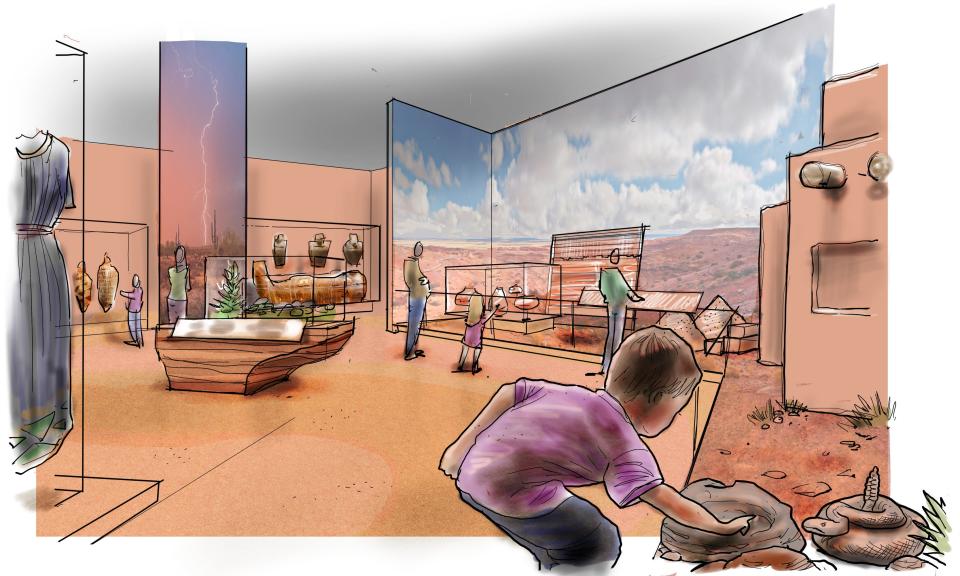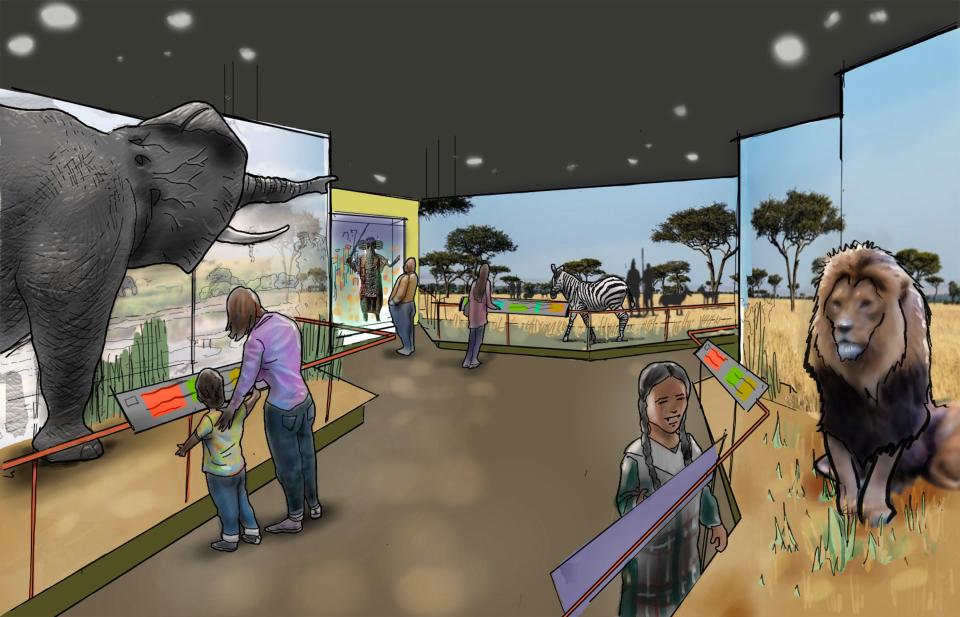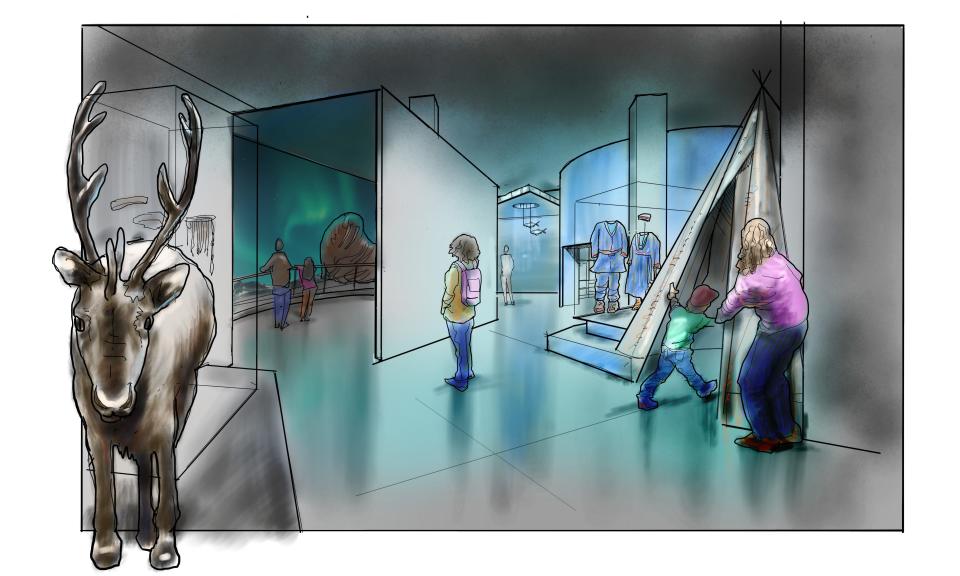Milwaukee Public Museum plans gallery in new building on world landscapes, cultures (and with the rattlesnake button)
The Milwaukee Public Museum on Tuesday announced some of the exhibits that will be in its "Living in a Dynamic World" gallery — the fourth gallery unveiled for the new museum.
The gallery will have five different halls, each dedicated to a distinct world landscape — deserts, the Arctic, islands, grasslands and mountains. Each landscape hall will include stories of distinct cultures that live there, including how they have adapted over time to live in their environments.
"The exhibits and cultures highlighted in Living in a Dynamic World were chosen with our vast collections in mind, and we'll be showcasing both familiar and never-before-seen items in the context of cultural stories, which are being developed in consultation with origin communities," Ellen Censky, the museum's president and CEO, said in a statement.
Museum administrators and designers also announced details of the new museum's two mixing zones, which will provide space for the museum to rotate through different collections that typically have not been on display.
The immersive exhibits will include elements and collections brought over from the current museum, including the popular re-creations Milwaukee County Zoo gorilla Samson, Simba the lion and Timba the elephant, as well as the famous "Muskrats" exhibit — the first of the influential "Milwaukee-style" dioramas that became an industry standard.
And, importantly for Milwaukeeans who love the Easter eggs of the current museum, this is the gallery where visitors will be able to find the rattlesnake button.
Here are details of some of the exhibits that will be in Living in a Dynamic World.
The Dynamic Planet exhibit
Visitors will enter the Living in a Dynamic World through the Dynamic Planet exhibit, which will have some of the following elements.
The Living Globe will be in the center of the space. Visitors will be able to choose different global systems on the interactive globe — such as ocean currents, seasonal migrations, trade routes and seismic activity zones — to learn how they interact with each other.
The Spice of Life exhibit will be a scent box with three different spices. Visitors can choose spices to smell and learn about how they've spread across the world and how they're consumed.
Before entering each of the landscape halls, visitors will encounter mosaics filled with "curiosities to discover and drawers to open, featuring items that define the landscape."
The Deserts Hall

The hall dedicated to deserts will utilize the museum's collections to spotlight a distinct environment of southeastern Arizona.
Culture of the Hopi Nation: This part of the museum will tell stories of Hopi people through exhibits that include a replica of a traditional Hopi dwelling, as well as artifacts in the museum's collection. "We are excited to tell the story of Nampeyo, an incredibly skilled ceramicist who maintained Hopi pottery traditions by passing down her craft to her daughters and granddaughters," Helen Divjak, senior curator of MPM's design partner, Thinc Design, said in a statement. "MPM has many of Nampeyo's beautiful pottery pieces in its collection that will be showcased in conjunction with her story."
Culture of ancient Egypt: This part of the gallery will include collections items like funerary objects and a tomb to highlight how the desert affected ancient Egyptians' beliefs about death.
Rattlesnake button: According to the museum's statement, "Hidden within the desert scenery, visitors will have to find the rattlesnake button — continuing a cherished tradition from the current museum and sharing that spirit of discovery with others." This area also will include exhibits showing how humans have adapted their footwear to protect them from snake bites.
The Richard & JoAnn Beightol Grasslands Hall

The African Serengeti scene will have exhibits with Timba the elephant and Simba the lion, two animals that "live" in the current museum.
In the American Plains area, similarities and differences between Indigenous Plains peoples will be explored.
The Arctic Hall

There will be exhibits dedicated to Nordic Sami people and North American Inuit people.
One immersive scene on the northern European tundra on a midsummer night will show reindeer eating moss, with the summer sun still above the horizon at midnight.
Another scene will feature Inuit people on North American ice during a midwinter day with walruses resting on ice floes, as well as storytelling about hunting and ice fishing.
The Islands Hall
This hall will focus on life and cultures in the South Pacific and the Ainu, an Indigenous people in Japan.
An exhibit will have scenes that start on the surface of the water and progressively dive deeper into the sea to teach about maritime navigation, animals and fish and the impact of pollution.
The Mixing Zones
There will be a three-story glass showcase showing off a variety of items in the museum's collections, including the re-creation of Samson the gorilla.
The Burke Foundation Mixing Zone will show an inside look at what happens behind the scenes of a museum, exhibiting a window into collections storage areas where curators and scientists study artifacts and scientific specimens.
This mixing zone also will house a permanent exhibit highlighting the Muskrats diorama, which is in the current museum.
The Cultural Mixing Zone will be home to flexible exhibits, special events and programs.
"A platform for storytelling and community-generated research and initiatives, the Cultural Mixing Zone will be dedicated to flexible exhibits, public interaction and special events and programs for the community to participate in," said Censky. "The museum's collections may provide inspiration, or merely be a backdrop for members of the public, partner institutions and schools to share and showcase their many ways of knowing and understanding the world."
What other exhibit galleries will be in the new museum?
Ground will be broken for the new museum later this year, and Living in a Dynamic World will be one of the museum's five permanent galleries. The others are:
Time Travel, a gallery focused on the planet's deep past, including when dinosaurs roamed the Earth;
Wisconsin Journey, a gallery of exhibits focused on geological and cultural history in different regions of the state;
Milwaukee Revealed, an immersive gallery considered to be the spiritual successor to the current museum's Streets of Old Milwaukee;
Rainforest, an immersive exploration through tropical rainforests.
In addition to the five permanent galleries and the mixing zones, there will be a live butterfly exhibit and a planetarium.
Museum officials plan to conclude their roll-out of exhibit details with an announcement regarding the rainforest and butterfly exhibits on May 24.
RELATED: How the Milwaukee Public Museum's Streets of Old Milwaukee began, and how it has evolved
This article originally appeared on Milwaukee Journal Sentinel: How to find rattlesnake button, Samson in new Milwaukee Public Museum
